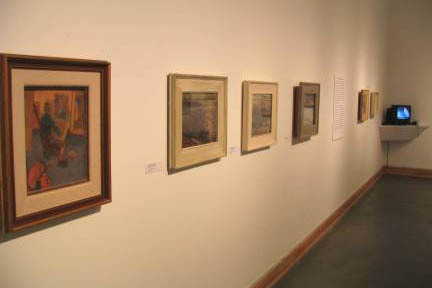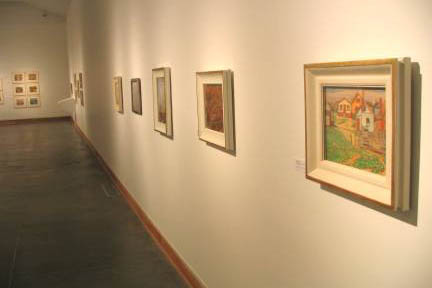December 2, 2006 to February 18, 2007
THE GROUP OF SEVEN
The Group of Seven had great ambitions when they officially formed in May 1920. Challenging what Canadian artists had done before them, they declared that “an Art must grow and flower in the land before the country will be a real home for its people.” A “real home” had not yet been created in Canada because, to their mind, Canadian art was still in an embryonic state. They perceived their role as one of fostering a sense of a national art, creating a fresh visual language that would capture Canada’s distinct identity, and asserting a difference from British forms of expression. The artist’s creative output thus had an important role in the forging of national identity: to provide a context—an imagined home, an imagined national community—and artistic bearings for a country that was still developing a sense of nationhood. Members utilized various artistic genres and experimented with a number of styles towards this common goal of a “national” art movement that was inspired largely by the Canadian landscape.
The Group of Seven were among the very first artists whose work was acquired for the Vancouver Art Gallery’s permanent collection, and today the Gallery owns some 170 works by the Group’s original seven members: Franklin Carmichael, Lawren Harris, A.Y. Jackson, Francis Johnston, Arthur Lismer, J.E.H. MacDonald and Frederick Varley. Dawn: Sketches by the Group of Seven features 30 painting sketches from throughout the careers of these artists. Dawn is the premier exhibition in the Vancouver Art Gallery’s new provincial touring program Across the Province, which circulates exhibitions drawn from the Gallery’s permanent collection to communities in British Columbia. The exhibition and tour is organized and circulated by the Vancouver Art Gallery with the generous support of The Rix Family Foundation.
PROCESS AND CULTURAL RELEVANCE
To achieve their objectives—to know the country, to paint it uniquely, to contribute to the development of a national community—the Group travelled extensively in the Arctic, Newfoundland, Ontario, Quebec and British Columbia. Members of the Group emphasized painting in the outdoors, and especially in what they conceived of as “the North,” a practice encouraged by Tom Thomson. Rather than working within the studio, they preferred the immediacy of painting their subject matter outside. Some of the resulting sketches seen on display here were later developed into canvases in the artists’ studios but others were themselves conceived as finished works and were exhibited as such in the artists’ lifetimes. This way of working was inherited from the Impressionists who were interested in capturing the effects of refracted light on canvas.
The purpose of trips to arguably “uncultivated” regions such as Algonquin Park, Algoma and other locales across Canada was to be in direct communication with the Canadian landscape’s spiritual essence and to “explore each region for those particular areas where form and character and spirit reached its summation.” Arthur Lismer wrote: “We became increasingly conscious of the fact that the spirit of the land must be discovered through its own character if there is to be any real life in its art.” As a result of these endeavours, the Group is still widely esteemed for its contribution to Canadian art, to a sense of Canadian wilderness and, more generally, to English-Canadian cultural iconography.
IMPACT ON CANADIAN ART AND CULTURE
Many art historians suggest the Group’s contribution to Canadian culture is related to how the nation is identified by its geographical uniqueness and a mythologized wilderness. Initially, members of the Group were deplored for both their painting style and their anti-modern bias. The most acerbic critic of their day, Hector Charlesworth, lamented their decision “to present in exaggerated terms the crudest and most sinister aspects of the Canadian wilds.” The Group has also been questioned by some contemporary critics for their depictions of a wilderness dispossessed of its Aboriginal inhabitants, and for being captivated by wilderness at a time when Canada was in the throes of modernization and industrialization.
Regardless of how they are regarded by such critics, the Group continues to be valued for its contribution to Canadian cultural mythology. Most critics concur that the Group of Seven’s canvases are worthy of their place in a national mythology and their identification with a national aesthetic. They are esteemed for their cultivation of the “national art scene”, for their encouragement of younger artists of their day such as Emily Carr, and for their pervasive influence upon succeeding generations of artists including the Canadian Group of Painters, a new association of artists that formed in 1933 out of the creative energy that originated in the Group’s work. The Group of Seven’s achievements paved the way for other Canadian artists and contributed enormously to the establishment of Canadian art on the international stage.











